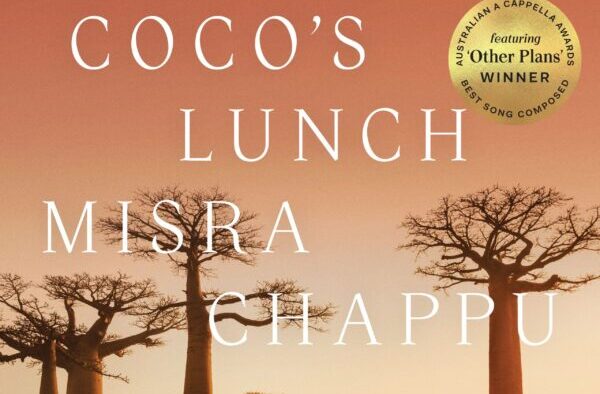Australian band Coco’s Lunch has come up with its new album Misra Chappu (https://cocoslunch.bandcamp.com/album/misra-chappu) beautiful music for an extraordinary year. It is an album which combines many genres and traditions, among them Australian, African and Indian rhythm. In this interview Lisa Young speaks about her fascination for odd metres and Carnatic music.
Why Misra Chappu? What is its appeal for you?
As a singer and composer interested in a wide variety of musical traditions, I am constantly exploring ways of bringing creativity to rhythmic expression. I’ve always engaged with odd metres and enjoyed exploring various configurations and sub-divisions of the musical pulse.
As a longtime student of maestro Guru Kaaraikkudi Mani in Chennai, my compositions and vocal language integrate the art form of konnakkol. So I have long been attracted to the Misra Chappu Talam and also I’m very fond of Kanda Chappu Talam and Sangeernam.
Many of my compositions often combine Western and Carnatic concepts. You can hear the use of the traditional intoned konnakkol and also the solkattu language forms the basis of vocal riffs, bass lines, melodies. So pitched and intoned konnakkol are heard as a fully integrated vocal and musical expression.
Many iconic Carnatic krithis as well as folk songs are in Misra Chappu. Have you heard any especially of Shyama Shastri?
I’ve heard some of these beautiful krithis, and before studying konnakkol I studied Carnatic vocal music for two years.
However my main dedication in the Carnatic tradition is to my konnakkol studies. I’m very fond of Kumari V. Shivapriya's performances of Misra Chappu structures, and very inspired by her double talam recitations.
Of course I have studied many of Kaaraikkudi Mani’s Misra Chappu structures which I adore. I also love the work of Chennai based ghatam and konnakkol artist Suresh Vaidyanathan.

Is there a culturalscape to rhythm. How is Misra Chappu uniquely Indian. Are there indigenous rhythms in Australia which resonate with this?
Whilst engagement with rhythm is heard across all musical cultures, it is developed with particular nuance and depth in different traditions.
There is an approach to metre and sub-division that is distinct and influential in Indian music. Here it is like a science, with the mathematical calculations, metric modulations and talam and nadai configurations. There is so much material to methodically study that provides musicians with a deep, rich, rhythmic foundation and awareness. This detailed systematic approach to rhythmic materials is generally absent in Western music pedagogy.
How does the interaction between dance and music as is seen in your video stimulate the aural and visual senses?
For the music video we wanted to connect the visual with the rhythmic grooves expressed in the song, and so it was a perfect opportunity to showcase the Bharatnatyam dance tradition, performed here by Vaishkarni Saieasan and choreographed by Narmatha Ravichandhira and Vaishkarni Saieasan.
The singers in Coco’s Lunch all love to interpret groove in performance. They are seen here keeping the tala hand gestures and engaging with the pulse. The interaction between the dancer and singers celebrates the integration of the Carnatic tradition in this contemporary piece. Hopefully the visual helps the listener experience the rhythms and sounds more deeply, and they can also imagine what it’s like to experience a live concert of Coco’s Lunch.
How does a non Indian artist bring in creativity to rhythm?
As an improvising singer and composer I am always exploring ways of bringing creativity to rhythmic expression. I love using polyrhythmic layers, metric modulation and rhythmic ambiguity. Compositionally I am often aiming to express a rhythmic conversation in my works, where ensemble members emphasise different rhythmic elements of the pulse that connect and displace within the sonic picture of the work.
It's the experience of layered rhythmic complexity that often creates a sense rhythmic depth in the music. In most pulse generated music there is usually an ongoing eternal pulse outlining the given metre; this is ‘felt’ or experienced in conjunction with at least one internal pulse layer sub-dividing the beats. There is also a fundamental relationship between a musician’s instinctive ability to internally subdivide a given metre, and their ability to explore and interpret rhythmic complexity and ‘groove’ in performance.
In Tha Thin Tha (https://www.youtube.com/watch?v=aC6kl549OTA), Misra Chappu and Other Plans, the harmonic and melodic material, the style of improvisation and the ensemble dialogue are strongly connected to the jazz tradition. Both the Carnatic and jazz approach to pulse and rhythmic metre are particularly influential forces in the works.
Could you tell us a little about the making of the video and your band.
The song 'Tha Thin Tha' integrates the art form of konnakkol with scat language to create a distinct sound-bank language as the basis for the vocal expression. The track features Australian mridangam and kanjira artist Sai-Sarangan Ravichandhira.
For the music video we wanted to immerse the visual in the Carnatic rhythmic grooves and show the connection with Bharatnatyam dance.
The director Lee Galea searched for performance space that would enhance the integration of these art forms and immerse them in a contemporary setting. We were thrilled to be able to shoot the clip at Magdalen Laundry North, Abbotsford Convent.
Coco’s Lunch is Lisa Young, Nicola Eveleigh, Jacqueline Gawler, Emma Gilmartin and Gabrielle MacGregor. We are composers and innovators of original vocal music, dedicated to an adventurous new direction in contemporary vocal music, transforming the traditional A Cappella genre with five-part South Indian vocal percussion, contemporary improvisation and complex songcraft.
The composers on the new Misra Chappu album - Lisa Young and Jacqueline Gawler - draw deeply from the rich sonic palettes of Australia, India and Africa, and between the five singers we bring the new stories on this album to life. The compositions combine our love of complex rhythmic interplay, poetry and challenging harmonic movement to bring a rich vocal sound to the fore.





